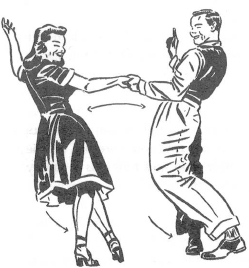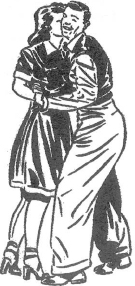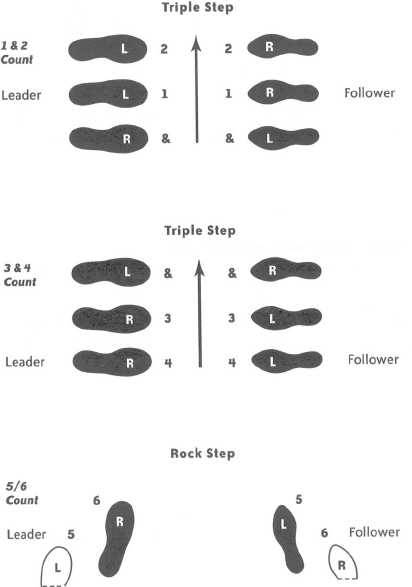The Swing Book (12 page)
Authors: Degen Pener

To become a righteous Lindy Hopper, you’ll want to take a series of classes with an experienced teacher. Getting hep to the Lindy requires patience and a certain amount of—let it be said—commitment. That can be frustrating at first for dancers who are accustomed to just going to a club and doing whatever they like. Lindy isn’t do your own thing. “This is a skill. This is like a sport. If I gave you a tennis racket would you believe me if I said you could go play Chris Evert after one class?” asks Seidenbaum. Although you can be assured that your first class will be instantly gratifying—you’ll be smiling and swinging before you know it— you’ll want to keep coming back and learning more.
To get even better, you’ll also want to watch out for workshops that studios hold with celebrated visiting dancers such as Manning; Ryan Francois, the choreographer of
Swing Kids
and his partner, Jenny Thomas, both of whom are appearing in the Broadway musical
Swing;
Charleston expert Louise Thwaite; the hip-hop-influenced Steven Mitchell; Singapore’s Sing Lim; and Sweden’s spectacular performance troupe the Rhythm Hot Shots. Many nightclubs offer free lessons in the evenings before the nightclub starts really hopping. You’ll also want to watch great old movies like
Hellzapoppin’
and
Buck Privates
for inspiration. Also, there are on-line instructions (see the Web guide in the appendix) and tons of teaching videotapes (see page 93 for a list of the best ones) available.
Watching any video or reading a book, however, is no substitute for actually doing the Lindy with a partner. So think of the information here as a briefing, a way to familiarize yourself with what you’ll hear and do in class, so that your body starts spinning and not your head.
Perfecting your basics, rather than knowing 150 tricky moves, is the most crucial part of being a great Lindy Hopper. “The basic is like your golf swing. You work on it your whole life,” says Paul Overton. And once you learn the basics, adds Frankie Manning, “all the other steps will come easily for you.”
What exactly is a basic? There are two types, the six-count and the eight-count. Each is simply a rhythm pattern you make with your feet. You can do them in place, while moving forward or backward, and while turning in a circle. They are the foundation upon which you base everything else, from styling to specific movements. Once you can do the basics consistently, you are freed to do countless other things with the rest of your body and simply enjoy yourself. “When your feet can do the steps without even having to think about it,” say Sylvia Skylar, “then you can spend all the time in the world thinking about and concentrating on your partner.”
To do the basics, you’ll need to get a grip on the following:
Counts: When you first start dancing you may need to count the beats of the rhythm. In swing music, the beats are syncopated. This means that there are stresses on beats that are generally unstressed. Think a-one-and-a-two. To do the Lindy you want to put emphasis on what is called the downbeat. For example, downbeats are the first beat and the third beat of a phrase, not the second and fourth. Of course, “once you get the numbers, lose the numbers,” says Erin Stevens of the Pasadena Ballroom Dance Association. “And feel it.”
Lead and Follow:
The Lindy Hop is referred to as a lead-and-follow dance, meaning that one person, generally but not always the man, leads the movements, while the partner, generally the woman, follows them. In this chapter the leader is referred to as he; the follower as she. But this is purely for the sake of convenience. Many men dance with other men, and women dance with women. Some same-sex couples are gay; some are not. In the Seattle swing scene, for example, lead and follow is a strictly gender-neutral affair. You can also get a better appreciation for the dance by learning the “other half” of it. “A lot of girls because they’re such fast learners will eventually learn how to lead too,” says Debra Sternberg. “It’s fun to know both.”
Arm Positions:
When you hold your partner’s hand, you want to feel a light tension between both of you. If the follower’s arms are too rigid, she isn’t responding to being led. If the follower’s arms are too limp, often referred to as “spaghetti arms,” she won’t be able to feel and respond to her partner. The right connection will enable you to be sensitive to the slightest pull and the lightest push from your partner. Also, neither partner should ever hyperextend his or her arms; you want to keep a slight bend in the arm, a gentle spring at the elbow.
Step to It:
Don’t plod or stomp around the dance floor. You want to keep a light, swinging feeling in your feet. No heavy shuffling, this isn’t work. Also, your steps don’t have to be as big as you imagine. You want to learn how to take small steps too, especially for when you’re on a crowded dance floor (see etiquette rule no. 3, page 93).
Body Positions:
There are two basic positions for the couple to be in: either open or closed. Open position is when you are facing and at arms’ length from each other, holding either one of your partner’s hands or both. For closed position, the leader puts his right arm behind his partner, his hand in the middle of her back. She rests her left hand on his right shoulder. He lightly holds her right hand in his left hand at waist height, keeping an easy tension in the arms with the elbows bent. Also, the pair should position their bodies in a slight
V
. You can also be very close together, with your torsos and legs touching. Think of closed and open positions as your home bases. If you’re stuck for what to do next, you can hang out there for a measure or so until you figure out a new move.

Open Position

Closed Position
Tempos:
It’s great when a dance band plays a mix of songs of different speeds throughout the night. If every number is at warp 10, you’ll be bushed halfway into the evening, while too many slow songs is boring. That’s why many Lindy Hoppers prefer bands—such as Bill Elliott or Indigo Swing—that play a lot of songs at midtempo. “The Lindy Hop is really about expressing yourself, and when the tempo isn’t as fast, you have more time to play with the music and put more movement into it,” says Steve Conrad, of the Arizona Lindy Hop Society. Some experienced dancers will even get quite technical, wanting to know how many beats per minute a song has, and a few Web sites go so far as to list the BPM of popular swing songs. So what are the best tempos? For a nice easy swing, anywhere from 140 to 180 beats per minute. For faster numbers, they can go up to 220 beats per minute, though you may have to dance single or double time, instead of triple, to keep up.
The six-count basic is one of the most important building blocks of swing dancing. It’s one of the two rhythm patterns that make up the Lindy, the other being the more challenging eight-count basic. It’s also the move that most people associate with jitter-bugging or East Coast swing. The basic can be done in many variations; this is an example done in closed position:
Starting in closed, do what are called triple steps on counts 1 and 2. These are syncopated movements that require three steps in two beats. If it’s helpful, think to yourself as you move
TRI
-ple-
STEP
,
STEP
-three-
TIMES
, or
ONE
-and-
TWO
to get the counting right. (For speedier numbers, you may want to dance in either double-time or single-time rhythm to go faster.) For triple time however, the leader steps on his left foot, then right foot, then left again, changing his weight three times. He’s not crossing his feet over each other. In fact, it should feel like you are doing the steps almost entirely in place, even though you’ll move slightly forward with your partner. The follower is doing the same steps, mirroring her partner but on the opposite feet, beginning with her right foot.
On counts 3 and 4, do another set of triple steps. The leader starts with his right foot; the follower with her left. And this time, the couple moves back to their starting point.

Six-count basic
On the next two counts, both partners do what’s referred to as a rock step. The leader should give his partner’s arm a gentle push with his left hand, opening up the space between the couple. As he does that, he puts his left foot behind his right on count 5, stepping only on the ball of the foot and “rocking” back on it. His partner does the same move with her right foot. At this point, both of them will have their hips more in line with each other than facing each other. On count 6 both leader and follower simply step on the other foot in place and come in close together again. Between the two steps, you should feel as if you’ve rocked back and forth.
“Until you have learned an eight-count step, you really aren’t dancing swing,” says Dance Manhattan’s Teddy Kern. “Because the music we’re dancing to is written in four-four time, it’s the eight-count in which you use up a whole phrase of music. It’s fundamentally important. When you dance an eight-count, you go, ‘Oh, wow, that’s where the music is.’” To do the eight-count, on counts 1 and 2 take a rock step. On 3 and 4, a triple step. You single-step on 5 and again on 6 in what’s called a walking step. And then on the last two counts, do a second triple step. (You can also choose to do the eight-count with the rock step coming at the end of the phrase). The eight-count can be done in numerous variations, with one of the most common involving doing a circle, beginning and ending in closed position. (Much of the Lindy, in fact, is done in circles. The dance is done, as dancers say, to all four walls.) Other eight-count variations include moving from open to closed position or beginning and ending in open position. The swing-outs come in the middle of these phrases on count 5. That’s when the leader releases or sends out his partner, allowing one or both of them to do an improvisational step.
Sure, you’re the one in charge, but leading isn’t about going off on some kind of power trip. In fact, it’s your job to make the dance the most wonderful experience possible for your partner. And that puts a lot of responsibility on your shoulders.
1. Reach Out and Touch Your Partner.
You’d be surprised how many guys in their first class are as shy as ten-year-olds about putting their hands on a woman. “I say, ‘Okay, now you’re going to have to put your arms around the ladies,’” says Manning. “And they’re reluctant you know. I say, ‘Fellas, touch the girl. She won’t mind.’” Some men, at first, don’t realize how clean, fun, and above all, safe touching in a social dance situation can be. “It’s not like it’s a come-on between you and your partner, though sometimes that happens,” says Dance Manhattan cofounder Elena Iannucci. “It’s dance intimacy.” Adds Lee Moore of the Flyin’ Lindy Hoppers, who often dances with his sister-in-law Tammy Finocchiaro, “It’s a contact sport. There’s not a part of her I don’t know.”
2. Think Ahead.
Because you decide what you and your partner are doing, you always have to be planning the next move. How do you choose which comes next? Let the music inspire you. Listen to the beat, the phrasing, and especially the feeling of the song. Also, you need to dance at the level of your partner. Don’t throw a slew of variations at a girl you’ve just met. Start simply and then begin to challenge her and see how far you can go together.
